How One Couple Revived the Legacy of a Legendary Ohio Glassware Company
Fran Taylor shattered expectations in the mid-20th century before her story was swept away by time. David and Jason Annecy brought her Gay Fad Studios’ name and inspiration back to Lancaster.
March/April 2024
BY Gracie Metz | Photos by Megan Leigh Barnard
March/April 2024
BY Gracie Metz | Photos by Megan Leigh Barnard
The Ohio Glass Museum’s oak display cases are filled with precious glass objects admired not only for their aesthetic beauty but also the bits of history held within their elegant, flowing shapes. The colorful collection celebrates Anchor Hocking, the glass company that opened in Lancaster in 1905 and still operates there today, as well as other glassmakers tied to the state of Ohio.
A large ball made of more than 600 individual blown-glass orbs is displayed in the museum during the year and hoisted above downtown each December for the city’s annual New Year’s Eve celebration, Glass Town Countdown. In the back of the building, a glassblowing studio hosts regularly scheduled demonstrations for visitors. The museum tells the story of how the glass industry shaped Ohio, but it also gives residents of Lancaster an appreciation for the place they call home. It was one of the first stops Jason and David Annecy made when the couple moved to the city in 2016, and during that visit, four specific pieces of glassware captured Jason’s attention.
“The only decorated glass they had in the whole museum was marked Gay Fad Studios, and the fact that it was decorated caught my eye, but I was also like, ‘that’s a peculiar name,’ ” he says. “Years went by, and I never thought about it again.”
Life went on, with Jason working in downtown Columbus for Nationwide Insurance, where he still works today, and David employed by the Ohio Bureau of Worker’s Compensation. Then in 2020, the local Rotary club asked Jason, who has a master’s degree in fine arts with a focus in design research from Kent State University, to create a concept for a new community mural to brighten the walls that line Center Alley in downtown Lancaster.
Having just helped complete a large mural honoring military veterans for the side of the Fairfield County Visitation Center along East Main Street, the Annecys were excited for another chance to help bring public art to the community and did the project pro bono. While sifting through potential themes that reflected local history, Jason recalled those pieces of decorated glass he had seen four years earlier and the unusual name of the company that made it: Gay Fad Studios.
As Jason and David delved into the business’ history, their research uncovered a largely forgotten piece of Lancaster’s past in the story of the company’s pioneering founder, Fran Taylor. Months after the mural’s completion, the research evolved into an ambitious plan, one in which the Annecys proposed reviving both the name and legacy of the business that last produced its glassware designs when John F. Kennedy was in the White House.
“We knew walking into this [that] this is a pretty bold idea,” David says. “It’s pretty bold to say we are going to take something that closed 60 years ago and figure out a way to resurrect it.”
---
Fran Taylor beams with confidence, dressed in dark-colored business attire with her hair perfectly coiffed, hands folded in front of her, bright eyes looking off to her right. The photo was taken in 1947 when Taylor was in her thirties, during the height of Gay Fad Studios, the business she started with just $30 in her pocket.
Between its founding in 1939 and closure in 1962, Gay Fad Studios was known for its artful, mid-century modern glassware adorned with colorful geometric patterns as well as caricatures and imagery that not only broke new ground in design but became highly sought after by collectors. The popularity of her glassware launched Taylor on a road to success — one that carried her far away from the poverty she experienced in her youth but also one fraught with challenges.
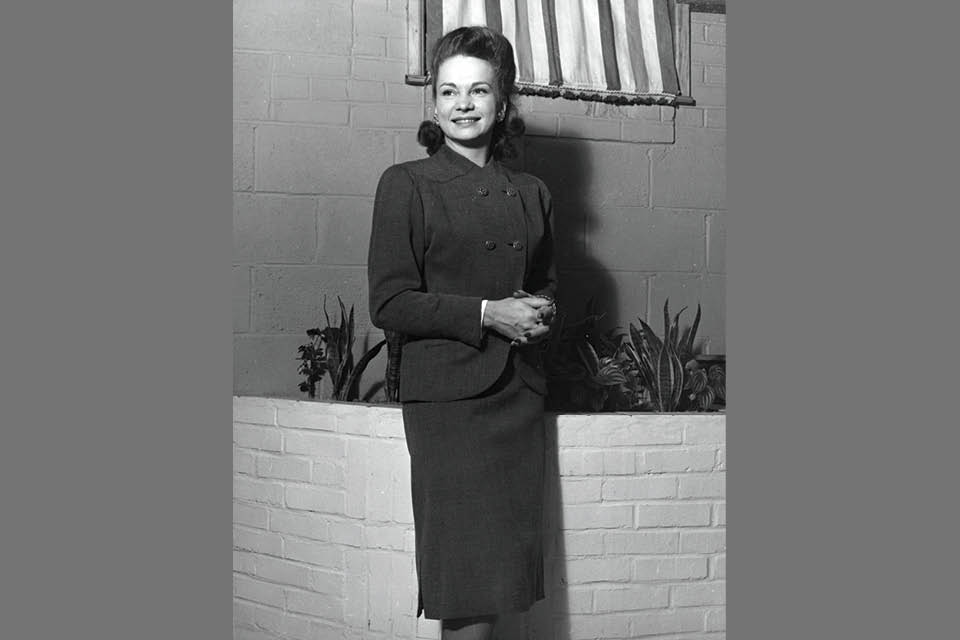
Fran Taylor founded Gay Fad Studios in 1939 and oversaw its production until its closure in 1962. She is pictured here in a photograph from 1947, during the height of her success. (photo courtesy of Gay Fad Studios)
The daughter of a Pennsylvania coal miner who immigrated to the United States from Poland, Taylor was the oldest of five children, and the responsibility of caring for her younger siblings often fell to her. After her 2-year-old sister died of pneumonia in her care, an 11-year-old Taylor was sent to live with her aunt in Detroit. When a mining accident put her father out of work, the rest of the family packed up and moved to Detroit as well — all of them sharing the same home.
Taylor graduated from Cooley High School before completing a degree in art and painting at Detroit’s Wayne University in 1938. After not being able to find a job out of college as a dress designer, her original dream, she began hand-painting her own designs.
“She wanted people to enjoy art in the everyday,” David says. “She especially loved to entertain, and even as a young adult, she was looking for fun, artistic items to entertain with, and she couldn’t find them, so she started decorating her own pieces.”
Taylor began by painting her designs on the side of metal waste bins. When they began to sell, she launched Gay Fad Studios in 1939. The business’ name came from her desire to bring about the joyous (gay) and the trendy (fad) using bright designs featuring nature motifs like florals, bees and landscapes to create products that stood out in a saturated market.
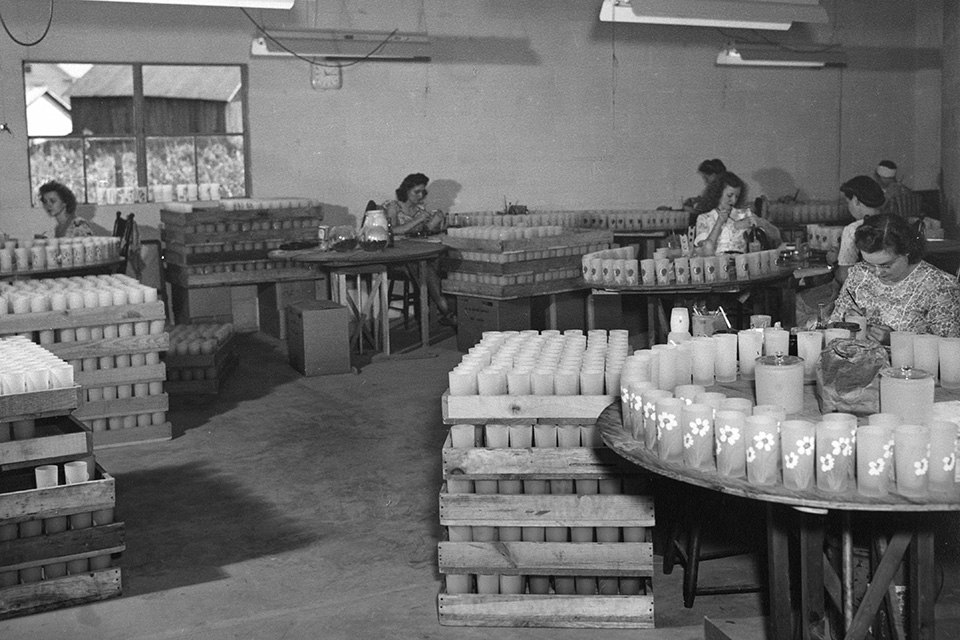
Gay Fad Studios employed more than 100 factory employees who worked in its 46,500-square-foot headquarters and production facility. (photo courtesy of Gay Fad Studios)
When World War II began, factories switched over to wartime production, making metal scarce, and Taylor needed a new plan. She learned glass was cheap and being produced in abundance in Lancaster and its surrounding cities, so she moved there in 1945. Her company operated out of a 46,500-square-foot headquarters and production facility on Pierce Avenue, and she created a unique company culture. Communal workspaces inspired employees to get to know one another during work hours, while the facility’s basement had both a bar that served after-work cocktails and a space where kids could play while their parents relaxed. Taylor would often come downstairs to read to the children before heading home. She even went as far as arranging buses to pick up female artists from more than an hour away and bring them to work.
The more than 100 factory employees produced the designs created by Taylor, Bill Butcher (the company’s female art director) and their team. When Taylor made the switch to using glass for her products, she had simply cold painted the designs on the surface, let them dry and sold them. After a while, customers began to complain that the designs were coming off, so she needed to find a new approach.
After working with an engineer for a year, Taylor found a way to make the designs permanent. Her employees used ceramic paint and pigment to hand-paint the glasses before placing them in an oven that heated the ceramic chips in the paint. The glasses were then cooled slowly, which made the designs adhere to the glass. After that, production soared, and by the late 1950s, Gay Fad Studios was a name known not just in Lancaster, but around the world. Taylor’s company was grossing $500,000 per year, equivalent to roughly $6.5 million today.
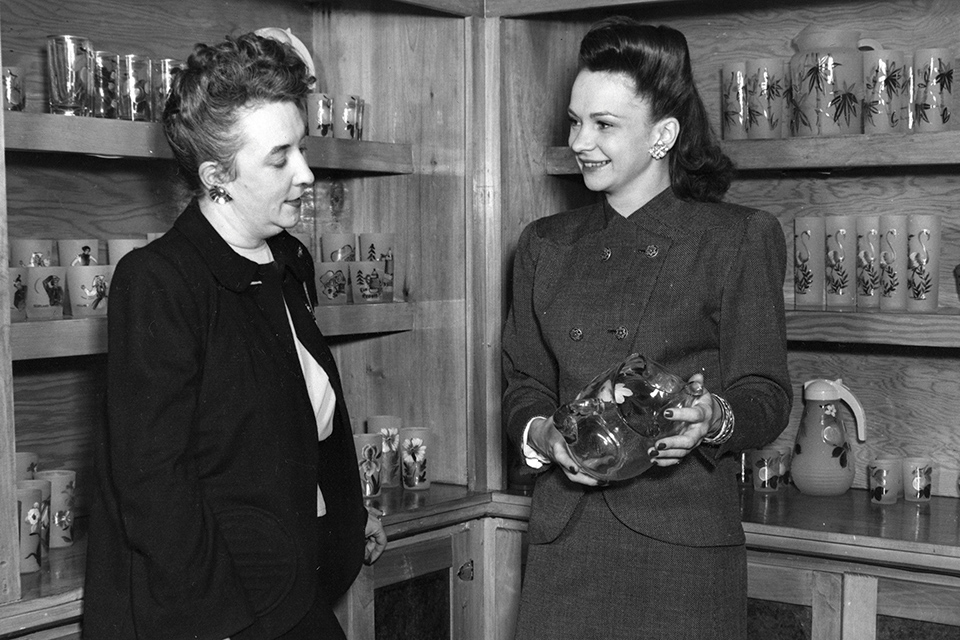
Employees produced designs created by Fran Taylor (right), the company’s female art director Bill Butcher (left) and their team. (photo courtesy of Gay Fad Studios)
Then, in 1962, Continental Can Co., a giant in the food-packing industry at the time, visited the factory on the cusp of a merger deal with Gay Fad Studios. Soon after, it began producing designs that Taylor and her employees believed had been stolen from them. From there, the troubles began to stack up.
Gay Fad Studios’ employees had already begun to unionize and went on strike in 1958, but by 1962, they were threatening to do so again. After multiple court battles, Taylor had a fire sale of her products, laid off her employees, closed her showroom in New York City and shuttered Gay Fad Studios in the summer of 1962. Following its demise, Taylor was in meetings to close out business matters. On the way home from one, she got into a car accident, which led to later health issues. Taylor never worked again and died in California in 1996.
***
A stunning royal blue background adorned with bright white starbursts and geometric patterns fills one wall along Center Alley in downtown Lancaster. On the opposite side of the brick-lined walkway, the procession of alternating patterns in a variety of vibrant colors are inspired by designs that adorned Gay Fad Studios’ glassware. The space is a popular spot for visitors to snap a selfie and, ideally, it makes them curious to learn more.
As they were developing the mural at the end of 2020, the Annecys worked with local historian Joyce Harvey to ensure the patterns were true to the Gay Fad Studios originals.
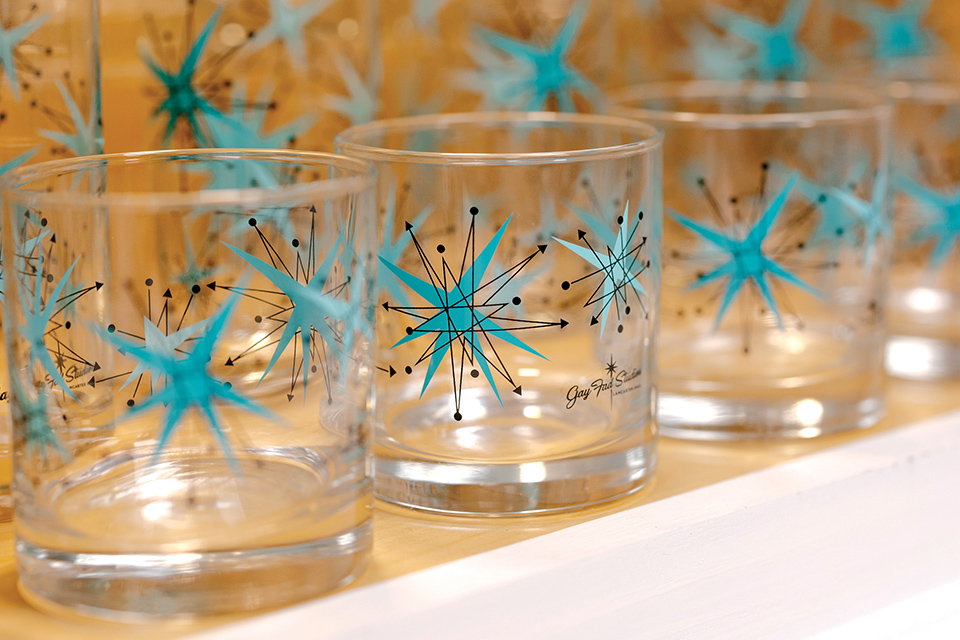
Gay Fad Studios’ products take inspiration from the company’s original portfolio, but the designs that adorn the shelves today are all conceived and created by Jason Annecy. (photo by Megan Leigh Barnard)
“I had helped them research the history for their house, so that’s how they knew of my interest in researching things,” says Harvey, who searched through old newspapers and local library resources. “They said ‘Can you see what you can find about Gay Fad?’ … that’s how I got into the project.”
After exchanging emails with Donna McGrady, a former resident of Lancaster who wrote a book about Gay Fad Studios, Jason learned that Taylor’s only daughter, Stephanie Taylor, lived in California and planned to come to Lancaster that summer for a family reunion. When she did, the Annecys met with her to share what they were doing to honor her mother’s legacy.
When the mural project was finished in October 2021, David and Jason were not ready to let go, fearing the legacy of Taylor and her business would once again fade into the past. At home, while watching a movie, Jason put together a rendering of what a revived Gay Fad Studios storefront could look like. David loved the idea but coming off a four-month mural project and having full-time jobs, it seemed like a lot to handle.
The original idea to keep the momentum behind Gay Fad Studios alive was to do a monthlong pop-up shop selling glassware items that went along with the new mural. In trying to find a space to host it, the Annecys went to Lancaster’s Park National Bank in February 2022 to discuss a long-vacant downtown building that happened to be located next to Center Alley. After a five-minute pitch outlining their vision — and getting Stephanie Taylor’s blessing — they secured the space for the project, receiving the keys in April 2022.
They were ready to reintroduce Gay Fad Studios to Lancaster with new glassware designs by Jason that honored the originals produced more than 60 years earlier. The Annecys papered over the building’s doors and windows and kept what they were doing a closely guarded secret, telling just three friends of their plans.
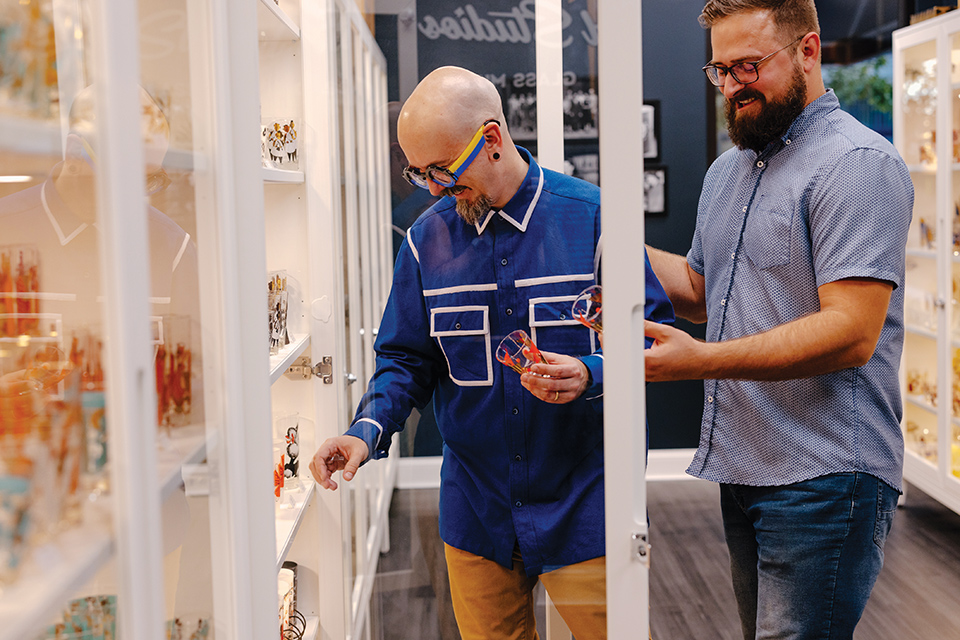
Jason (left) and David Annecy (right) have become the leading experts on Gay Fad Studios glassware as well as avid collectors of it. (photo by Megan Leigh Barnard)
As plans for the pop-up continued through the spring, the Annecys realized that with the amount of work they were doing on the building’s interior, it seemed natural to try to make the space a permanent retail destination. In July 2022, the building’s exterior was painted, and the new Gay Fad Studios opened as a complete surprise to the public two days later.
“It was, to us, pretty remarkable that we even got the opportunity,” Jason says. “I think it speaks a lot about the community for how much they believe in this.”
Custom cabinetry creates a minimalistic and clean backdrop for Jason Annecy’s continuation of the types of designs Gay Fad Studios originally made famous. Sunburst glass patterns in teal, pink, black and gold line the shelves, while wooden tables in the center of the showroom are full of colorful plates, bowls and glasses sourced from women-led companies throughout the U.S. and Europe.
Behind the counter, a deep-blue and white back wall with polished gold accents alludes to the 1957 Gay Fad Studios design “Snowtrees,” and a row of elegant and ornate glass figures made from repurposed chandelier pieces rises to meet the name Gay Fad Studios, presented in a style reminiscent of the one Fran Taylor used on her products. While Jason takes inspiration from the company’s original portfolio, the designs that adorn the shelves in the present Gay Fad Studios era all come from his mind, using Fran Taylor originals as well as the Lancaster community as his muse. The free-spirited nature of Taylor’s designs are still present in the modern-day styles Jason creates, which keep the tone of the originals alive while never being an exact copy of them.
“[One] camp is where we are taking the essence of something and then finding ways to reimagine it,” explains Jason. “It might mean taking pieces and parts from a wide variety of different glasses and then coming up with a new composition. Other times, it’s looking at a glass and saying, ‘I like that color. I like that motif. Let’s come up with something that looks like a sister to it.’ ”
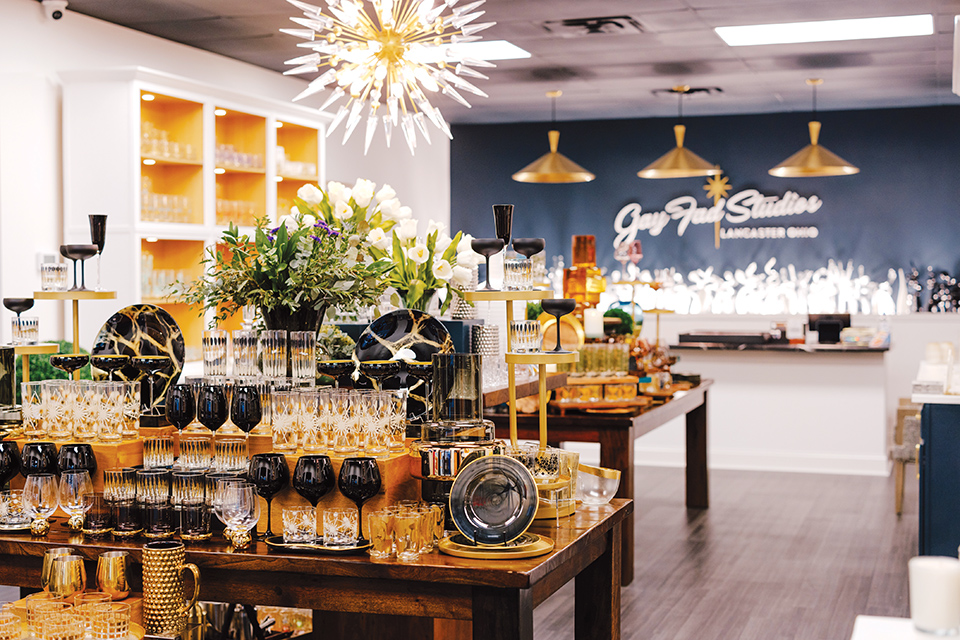
Gay Fad Studios’ showroom in Lancaster opened in summer 2023. (photo by Megan Leigh Barnard)
The store space is rich with history. It even houses a small museum just off the main showroom, which opened in July 2023 and serves as a testament to the Annecys’ desire to reignite the once-forgotten story of the hometown glassware pioneer. The museum’s shelves brim with original Gay Fad Studios pieces and historic photographs. Some of the artifacts came from the children and grandchildren of Gay Fad Studios employees, including the descendants of Butcher, who worked alongside Taylor for more than 30 years.
Not surprisingly, the Annecys have become the leading experts on Gay Fad Studios as well as avid collectors of its original glassware, having acquired more than 4,000 pieces in just shy of two years. They have also built an impressive collection of original catalogs, advertisements and photos. Although they do not feel the need to have every piece, they encourage those who might have a Gay Fad Studios original to contact them so they can catalog it. Since the store’s opening on July 20, 2022, they have received many emails and social media messages leading them to people who have glass to donate.
“To find the glassware has taken a community of — we like to call them ‘Fran-atics’ — people that we have befriended across the entire country that are focused on helping us find the glassware,” Jason says. “We kind of view ourselves as caretakers. It’s like, ‘How do we preserve it for more generations?’ ”
These days, the elegant shop draws curious travelers and locals alike, who often visit because they were drawn to the mural that adorns its exterior wall. The building’s inviting facade seems to indicate something special is happening there too. The Annecys are, of course, always happy to share the story of Fran Taylor, a woman who shattered barriers and pioneered her industry, with those who step through the front door.
“She graduated high school, put herself through college, got a degree in art and painting, started her own company, became a multimillionaire … [she] lived the American Dream,” David says. “[Fran was] decades ahead of her time and was just so fearless and so determined.”
137 W. Main St., Lancaster 43130, 740/277-6883, gayfadstudios.com
Related Articles

New Book Details Origins and Evolution of Dayton’s Carillon Historical Park
The destination’s vice president of museum operations Alex Heckman and curator Steve Lucht wrote the 222-page, hardbound coffee-table book. READ MORE >>

Two Ohioans Appear on the Hallmark Channel’s ‘Finding Mr. Christmas’
This holiday-themed reality show searches for the next Hallmark star, and Ohio natives Marcus Brodie and Logan Shepard are among the contestants this season. READ MORE >>

‘Ohio: Wild at Heart’ Now Showing in Select Theaters Statewide
Produced in partnership with the Ohio Department of Natural Resources, this film showcases some of our state’s most striking natural features. READ MORE >>



